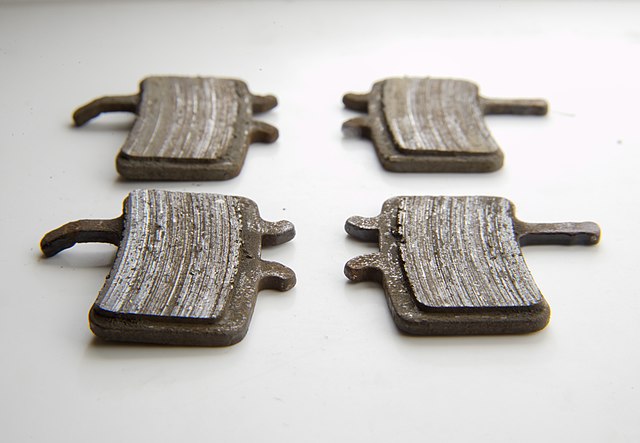There’s no question that brake pads are one of the most important components in your car. What’s the good in being able to drive fast if you can’t also slow yourself down in a safe distance? So when it’s time to replace your brake pads, you may find yourself looking at a range of options with various price tags. Not all brake pads are created equal, and different materials offer different advantages.
Over the history of braking systems, there have been a variety of materials used to produce friction. From leather to asbestos, engineers have always been creative when it comes to getting the most out of their brakes, and have progressed greatly in which materials we use.
There are three main material types used for pads in modern vehicles: organic, semi-metallic, and ceramic. Each of these materials provides varying benefits and drawbacks depending on the vehicle and the driver.

Organic Brake Pads
Organic pads are the most common type of brake pad on modern vehicles, with about 67% of new cars sold in the U.S. making use of organic friction material. Often made using mixtures of rubber, glass/fiberglass, carbon materials, Kevlar, and resin, organic pads are the cheapest of the major brake pad types, which contributes to their popularity in commuter vehicles.
While being the cheapest, organic pads also happen to be the worst in most categories. They do their job well enough to be suitable for the majority of vehicles and drivers out there, but fall flat in performance and longevity compared to their more expensive counterparts.
Semi-Metallic Brake Pads
Coming in between the price range of organic and ceramic pads, semi-metallic brake pads have seen widespread adoption in performance vehicles for their superior stopping power and heat resistance.
Semi-metallic pads consist of a mix of metals such as iron, copper, and steel along with filler material like graphite lubricant. The ratio of metal to filler can range anywhere from 30%-70% metal. Pads completely made of metal do exist but are only used in situations with extreme braking and a complete focus on performance, such as in purpose-built race cars.

Semi-metallic pads have the greatest stopping power compared to either organic or ceramic pads while also performing better in extreme weather or at higher temperatures due to their ability to conduct heat. As a result, metallic pads have a strong cold bite (ability to produce friction in cold conditions) and are resistant to brake fade (decreased performance when at high temperatures).
However, semi-metallic brake pads are not without their drawbacks.
Pads that contain metal will always be noisier compared to other materials, which can make semi-metallic pads annoying for those who use their car to commute to work or otherwise drive it often.
They also produce the most brake dust of any of these options, while also wearing out the rotors at an increased rate due to their metallic makeup.
Ceramic Brake Pads
Coming in at the top of the price range, ceramic pads are a more recent development and bring some serious benefits to the table.
Ceramic pads consist of a pottery-like material infused with strands of copper for increased heat conduction. Due to this complex manufacturing process, ceramic brake pads demand a hefty price tag.
So, what are you really getting for your money? Ceramic pads fall in between organic and semi-metallic pads in terms of stopping power but excel past them in various other metrics. Their unique material gives them stellar performance while being quieter and more durable than their counterparts. Ceramic produces considerably less brake dust and little to no noise when applying the brakes.
They’re also the easiest on the brake rotors, meaning you won’t go through them as quickly as you would with organic or metallic pads.
With all these benefits though, there have to be some downsides beyond just the price.
Ceramic brake pads have poor heat absorption, which allows heat to transfer to the surrounding components of the braking system and wear them faster. Drivers of vehicles with ceramic pads should avoid heavy and aggressive braking to avoid the buildup of heat.
They also lack the impressive cold bite of metallic pads and will need to get up to the proper temperature before operating with their optimal stopping power.
Which Brake Pads are Right for Me?
What pad material is right for you and your vehicle depends on a variety of factors.
Organic pads will be suitable for the majority of drivers on the road. If you’re not using your vehicle very often or just use it to run errands, there’s a good chance that organic pads will be more than enough for you (these are used by most major manufacturers for a reason).
If you’re looking for a performance-oriented option, semi-metallic brake pads may be the right choice. Metallic pads hold up to harsh conditions and aggressive braking much better than organic pads, and provide you with stellar braking power whenever you may need it. Whether your car sees spirited canyon driving or serious track time, semi-metallic pads will give you optimal performance.
Ceramic pads provide extensive benefits but are aimed at a specific customer. You could consider these pads the most luxurious, mainly due to their silent braking, firm feel, and increased durability. If you’re driving your vehicle often or taking it on frequent trips and are looking for the ultimate brake pad, ceramic provides unique benefits that just aren’t seen at any other price point. While not the best in terms of braking power, ceramic pads may just be worth their premium cost for certain drivers.
Brake Service at Alex’s Autohaus
The expert technicians at Alex’s Autohaus in Midvale have the expertise and equipment to properly service or repair your European vehicle’s braking system. Call or schedule online with us today!
The post Semi-Metallic vs. Ceramic Brake Pads: Which is Right for You? appeared first on European Auto Repair in Salt Lake City | www.alexsautohaus.com | (801) 566-6115.